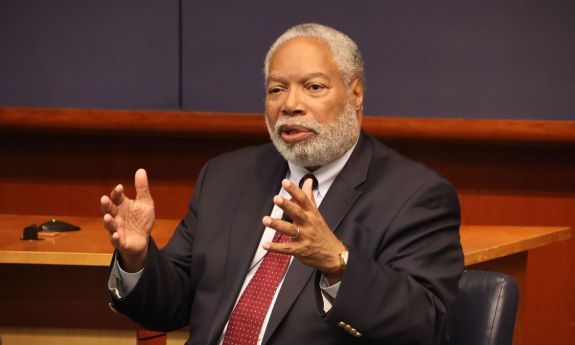Smithsonian Director on Building a Museum for All Americans
Lonnie Bunch III shares the vision behind the network of museums, libraries and the National Zoo

Bunch is one of America’s preeminent historians and storytellers of this nation’s history. In 2019, he became the 14th Secretary of the Smithsonian. His duties include overseeing 21 museums, 21 libraries, the National Zoo, numerous research centers and several education units and centers.
Previously, Bunch took on planning and construction of the NMAAHC as its inaugural director in July 2005. He started the effort with one staff member, no collections, no funding and no site for a museum.”
Today, the NMAAHC sits on the National Mall next to the Washington Monument. It is one of the top four destination sites at the Smithsonian with more than 11 million visitors since its opening on Sept. 24, 2016.
Bunch’s appearance at the law school followed a trip by Duke faculty and staff to the NMAAHC, where the secretary served as their tour guide. During the tour, “the idea for a discussion here emerged,” Jones said.
North Carolina has formative ties to the development of the NMAAHC. The lead architect, Phil Freelon, had been living in Durham for decades before he died in 2019. Several Duke faculty served as advisers in museum planning.
“John Hope Franklin used to say to me that you’ve got to do two things. One, you’ve got to tell the unvarnished truth, and that means there’s going to be pain, there’s going to be violence, there’s going to be issues. But on the other hand, you’ve got to make sure that when people go through the museum, they’re changed.”
Lonnie G. Bunch III
Bunch, a native of New Jersey, also has deep ties to the state. His grandfather was a sharecropper living in Zebulon and attended Shaw University at night.
“It took him 10 years to graduate college,” Bunch said. “He then decided he wanted to be a dentist and went to Howard [University].”
Bunch’s father also attended Shaw and met his mother.
“So, because of Shaw [and] North Carolina, I am,” he said.
Bunch tells the story of creation of NMAAHC in his new book “A Fool's Errand: Creating the National Museum of African American History and Culture in the Age of Bush, Obama, and Trump.” At Duke, he shared the philosophies that guided his vision for the museum.
Decades before, Bunch discovered the “holy grail” at the foundation of his philosophy of history when he met Princey Jenkins, a 90-year-old man who lived in a cabin on a rice plantation in Georgetown, S.C.where his enslaved grandmother once lived.
“(Princey) said to me, ‘I’m not sure what a historian does, but if you’re a good historian, isn’t your job to help people remember, not just what they want to remember, but what they need to remember?’” Bunch said. “And that changed everything. That’s really the subtext of the museum.”
Bunch also heeded the advice of the late, celebrated Duke historian John Hope Franklin, who chaired the museum’s advisory committee.

“John Hope Franklin used to say to me that you’ve got to do two things. One, you’ve got to tell the unvarnished truth, and that means there’s going to be pain, there’s going to be violence, there’s going to be issues,” Bunch said. “But on the other hand, you’ve got to make sure that when people go through the museum, they’re changed.”
Bunch said he hired people who understood his vision and “who also believed that others didn’t think we can do this. So, let’s have a little bit of a chip on our shoulder to get this work done.”
“The overall goal was to craft a museum that one the one hand, would force America to deal with its tortured past, but it also had to be a museum that found joy, that would allow you to tap your toes to Duke Ellington or Louis Armstrong or somebody from the hip hop world.”
For Black Americans, a museum celebrating the African American experience was long overdue.
From attics, garages, basements long forgotten: the museum has collected more than 35,000 relics, including Bunch’s first great find: 33 objects that were part of Harriet Tubman’s legacy, including photos of her funeral and a hymnal book that contained spirituals the great conductor of the underground railroad would sing while traveling in the South.
Bunch secured the collection, worth millions of dollars, with a handshake.
“And it’s that generosity that people were waiting for this story, waiting for a place that would say, ‘this is valuable, this is essential.’”